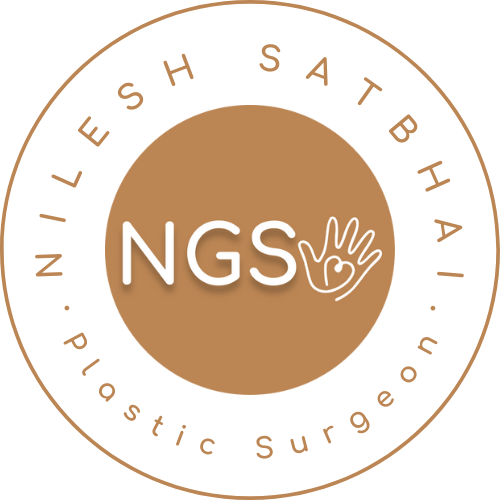7 Everyday Habits That Can Hurt Your Hands
Our hands are incredible tools that help us navigate the world around us, but they’re also surprisingly vulnerable to injury. From smartphone overuse to gardening mishaps, the everyday habits we engage in can lead to hand injuries that may require the expertise of a skilled plastic surgeon like Dr. Nilesh Satbhai. In this blog, we’ll delve into the importance of hand health, how common daily activities can harm our hands, and the role of hand surgery in treating these injuries.
1. Smartphone Overuse
Smartphones have become an indispensable part of our lives. We rely on them for communication, information, and entertainment. However, the repetitive nature of smartphone use can lead to hand injuries, such as tendinitis and carpal tunnel syndrome. Tendinitis, in particular, is inflammation of the tendons, often caused by repetitive movements of the wrist and fingers when using a smartphone. Carpal tunnel syndrome is a condition in which pressure on the median nerve in the wrist can result in pain and discomfort. It can lead to nerve damage.
These common injuries affect the range of motion and can lead to severe pain if left unattended for a long time.
Restore the funtion of nerves
Reviving Nerve Functionand Mobility
To mitigate the risk, it’s essential to practice ergonomic smartphone use. Hold your phone in a way that minimizes strain on your hand and wrist. Take frequent breaks, and consider using voice commands or a stylus to reduce the strain on your fingers.
2. Computer-Related Strain
Many of us spend hours each day working on computers, which can lead to hand strain. Repetitive Strain Injuries (RSIs) are common among those who use computers extensively. These injuries can affect the hands, wrists, and arms, causing pain, tingling, or numbness.
The solution lies in setting up an ergonomic workspace. Ensure your keyboard and mouse are at the right height, your wrists are well-supported, and you take regular breaks to stretch and flex your hands. By doing this, you can avoid wrist injuries to a great extent.
3. Lifting Hazards
Improper heavy lifting techniques can not only strain your back but also lead to hand injuries such as sprains and strains. When you lift a heavy object without using the proper technique, the strain can concentrate on your hands and fingers.
To avoid such injuries, always lift with your legs and not your back. Utilize proper lifting equipment when necessary, and wear protective gloves to minimize the risk of hand injuries.
Some of you might be getting confused as to what is the role of a plastic surgeon in these kinds of injuries.
For inquisitive readers like you, I’ve prepared a short video which explains in detail the advancements in plastic surgery. I am sure, you’ll get tons of information after viewing it.
Let’s now continue our discussion further.
4. Musicians and Hand Injuries
Musicians are artists who use their hands to create beautiful melodies. However, overuse injuries are common in this profession. Playing musical instruments often involves repetitive hand and finger movements, which can lead to conditions like tendinitis and even carpal tunnel syndrome.
Preventive measures for musicians include proper warm-up exercises, stretching routines, and occasional breaks during practice. Plastic surgeons like Dr. Nilesh may become involved in these cases in the context of specialized surgical procedures or if cosmetic and aesthetic concerns arise, particularly when an injury results in visible scarring.
Musicians, regardless of their instrument or genre, are susceptible to hand injuries, but certain types of musicians may be more prone to specific conditions:
Pianists: Pianists often face overuse injuries, particularly in the wrist and fingers. Conditions like tendinitis and carpal tunnel syndrome can be more common due to the repetitive and intricate finger movements required to play the piano. Wrist injuries are common with pianists and guitarists.
Guitarists: Guitarists may experience issues like calluses, blisters, or nerve compression in the fingers due to constant contact with the strings. This can lead to discomfort and pain in the hands.
String Instrument Players: Musicians who play instruments like the violin, cello, or double bass may develop conditions like trigger finger, in which a finger gets stuck in a bent position, or De Quervain’s tenosynovitis, which causes severe pain and swelling in the thumb.
Wind Instrument Players: Musicians who play wind instruments such as the flute or saxophone are more prone to lip and facial injuries rather than hand injuries. However, the repetitive nature of finger movement required for key manipulation in some wind instruments can lead to hand strain.
Drummers and Percussionists: Drummers use their hands extensively and can develop overuse injuries, including tendinitis, in the wrists and fingers due to the constant striking of drums and percussion instruments.
Individuals with pre-existing medical conditions such as diabetes or other disorders that affect circulation and wound healing may indeed face additional challenges when dealing with hand injuries. Diabetics, for instance, may experience delayed wound healing and a higher risk of infection due to compromised blood flow and nerve function.
Therefore, any hand injury, no matter how minor, can potentially lead to more complex wounds in individuals with these conditions. Such individuals must seek immediate medical attention for even minor hand injuries to minimize the risk of complications and ensure proper wound management. Dr. Nilesh Satbhai, with expertise in plastic surgery, can play a vital role in managing and treating these complex hand injuries in individuals with underlying medical conditions.
5. Gardening and Yard Work
Gardening is a relaxing and fulfilling activity, but it can also result in hand injuries. Common conditions include tendonitis, stress fractures, and cuts from tools.
Restoring amputated fingers
Learn about the science behind replantation
To ensure hand safety while gardening, use appropriate gloves to protect against blisters and cuts. Maintain proper posture and use ergonomic tools to minimize strain on your hands and wrists.
6. Kitchen Safety
Cooking is another daily activity that poses risks to our hands, particularly for those who engage in repeated motions and lifting heavy objects. Common kitchen-related hand injuries include cuts, burns, and even accidental knife injuries.
Repetitive Motions in the Kitchen
Repetitive motions in the kitchen, such as chopping, stirring, and kneading, are often essential for preparing delicious meals. However, these repetitive actions can lead to hand injuries over time. Here are some common issues:
Carpal Tunnel Syndrome:
Consistent chopping and slicing can cause inflammation and compression of the median nerve in the wrist, leading to carpal tunnel syndrome. This condition can result in pain, numbness, and weakness in the hand.
Flexor Tendon Tendonitis:
Frequent stirring and whisking can strain the tendons in your hand, leading to tendonitis. Tendonitis causes pain, swelling, and reduced hand mobility.
To reduce the risk of these injuries, it’s crucial to practice good ergonomic techniques in the kitchen. Use knives with ergonomic handles, take regular breaks, and stretch your hands and wrists to prevent strain. Additionally, consider using aids like food processors or standing mixers to reduce the strain on your hands.
Lifting Heavy Objects in the Kitchen
Lifting heavy objects in the kitchen can also lead to hand injuries, especially when done repeatedly. Here are some potential issues:
Strains and Sprains:
Lifting heavy pots, pans, and containers can strain the muscles and ligaments in your hands and wrists, leading to strains and sprains.
Accidental Burns:
Carrying hot and heavy cookware increases the risk of accidental burns, which can be painful and lead to blisters.
To avoid these issues, follow these safety tips:
-
When lifting heavy pots or pans, use both hands and maintain a firm grip to distribute the weight evenly.
-
Consider using lightweight cookware or cook in smaller batches to reduce the load.
-
Be cautious when handling hot items. Always use oven mitts or pot holders to protect your hands from burns.
-
If you’re experiencing discomfort, pain, or persistent symptoms related to repetitive motions or heavy lifting in the kitchen, consult a medical professional or specialist like Dr. Nilesh Satbhai for appropriate diagnosis and treatment options. Don’t ignore hand injuries, as timely intervention can prevent them from becoming more severe.
By being mindful of the risks associated with repetitive motions and heavy lifting in the kitchen, you can better protect your hands and enjoy your culinary pursuits without the worry of hand injuries. Your hands are invaluable, so ensure they receive the care and attention they deserve to remain healthy and pain-free.
7. Sports and Physical Activities
Engaging in sports and physical activities can lead to various hand injuries, some of which may require the expertise of a plastic surgeon like Dr. Nilesh Satbhai. While orthopaedic surgeons primarily address fractures and dislocations, plastic surgeons play a crucial role in managing specific hand injuries that affect not only function but also the aesthetic appearance of the hand.
Soft Tissue Injuries
In sports like basketball or rugby, hand injuries often involve more than just fractures and dislocations. Soft tissue injuries, such as deep cuts, lacerations, or abrasions, can be severe and may damage nerves, blood vessels, and other structures. These injuries may require plastic surgery to repair damaged tissues, restore function, and minimize scarring.
Traumatic Injuries to Fingers
Accidental trauma during sports can result in injuries to the fingers, including amputations or avulsions. In such cases, plastic surgeons are trained to perform microsurgical procedures to reattach severed fingers or parts of the hand. These delicate surgeries aim not only to restore function but also to ensure the hand looks as close to its natural form as possible.
Reconstruction After Ligament or Tendon Injuries
Sports often involve rapid movements, which can lead to ligament and tendon injuries in the hand. These injuries can severely impact hand function. Plastic surgeons can play a critical role in the reconstruction of damaged ligaments and tendons. Techniques such as tendon grafting or tendon transfers may be employed to restore hand mobility and dexterity.
Minor injuries to the brachial plexus are common in sportspersons like football players and wrestlers. Athletes involved in football, a sport known for its physical intensity and tackling, are at higher risk of experiencing such injuries, especially when tackles involve direct impact to the shoulder and upper arm area. Similarly, wrestlers, who engage in close-quarters combat, are also prone to minor brachial plexus injuries when their shoulders or arms are forcefully twisted or compressed.
Understanding Brachial Plexus Injuries
Unraveling the Hidden Dangers and Treatment Options
Nerve Injuries and Repair
Hand injuries in sports may involve damage to nerves, resulting in sensory and motor deficits. Plastic surgeons are well-equipped to handle nerve injuries. Nerve repair or grafting procedures are used to reestablish sensation and movement in the hand, ensuring it not only functions well but also feels normal.
Cosmetic Concerns
Beyond functionality, plastic surgeons focus on the aesthetic aspects of hand injuries. Scars, particularly in visible areas of the hand, can be a source of concern. Plastic surgeons employ techniques to minimize scarring and improve the cosmetic outcome of hand injuries. This is especially important for athletes, as they often prioritize not only functionality but also the appearance of their hands.
While orthopaedic surgeons address the structural aspects of hand injuries in sports, plastic surgeons like Dr. Nilesh Satbhai are indispensable for managing soft tissue injuries, amputations, nerve damage, and the aesthetic concerns that often accompany hand trauma.
Whether it’s a star athlete or a weekend sports enthusiast, the comprehensive care provided by plastic surgeons ensures that the hand not only heals but also regains its full function and appearance, enabling individuals to return to their active lives with confidence.
In our daily lives, our hands are invaluable, and their health should never be underestimated. Understanding the potential risks associated with everyday activities and taking preventive measures can help protect these vital tools. Remember, if you ever face a hand injury or discomfort that requires medical attention, don’t hesitate to consult a specialist like Dr. Nilesh Satbhai. Your hands deserve the best care to keep them functioning at their best and pain-free.











